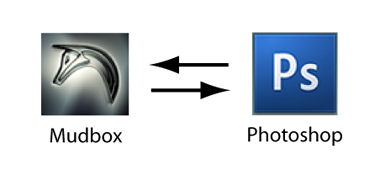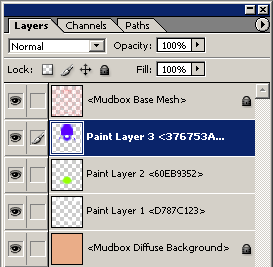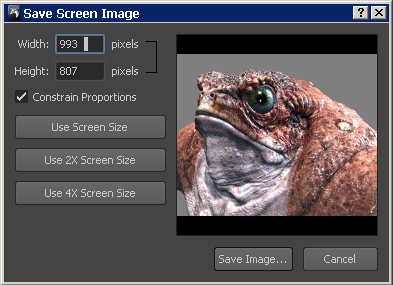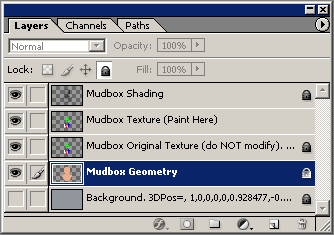Paint
layers can be exported from Mudbox as Adobe® Photoshop® files (.psd file format). The .psd format
files can either be edited or used as reference layers within Photoshop,
saved, and subsequently re-imported to update the original paint
layers within Mudbox.
The paint layer and channel
export features greatly reduce the number of steps required to work
between Mudbox and Photoshop by sharing files in a more seamless
manner and take advantage of the powerful features within each application.
Three workflows are possible:
- Export a single paint layer from the
paint layer editor with an additional layer containing an image
of the UV layout. You can edit your paint textures using the UV
layout layer as a reference and import the edited layer back into
Mudbox. For more information, see
Export a single paint layer to Photoshop.
- Export an entire paint channel containing
multiple paint layers including a layer containing an image of the
UV layout. You can create and edit your paint layers using the UV
layout as a reference and import the edited paint channel back into
Mudbox. For more information, see
Export a paint channel containing multiple layers to Photoshop.
- Export an image of your model as it appears
in the 3D View so you can create new
paint textures or perform touch up work on existing ones using the
tools within Photoshop and the 3D model view as a reference. Importing
the file back into Mudbox automatically projects the texture updates on
the model and updates the textures. For more information, see
Export a paint layer of the 3D View.
Export a single paint layer
to Photoshop
- (In Mudbox) In
the Layers window, ensure the display
button is set to Paint.
- Select the paint layer you want to export.
- From the Layers window
menu (
 ), select Export
Selected. (Right -clicking the paint layer also displays
the same menu).
), select Export
Selected. (Right -clicking the paint layer also displays
the same menu).
The Save
As window appears.
- Select a directory, enter a filename,
and then set the image format file type to: Photoshop
{8bit, RGBA} (.psd) before clicking Save.
A .psd format file is
saved from Mudbox.
- (In Photoshop) Open
the .psd file containing the paint layer you exported from Mudbox.
The Layers window in
Photoshop (Hotkey: F7) displays the paint layers. The .psd file
contains two layers:
- Mudbox Base Mesh -
A layer that includes an image of the UV texture coordinates (based
on how they appeared on the base subdivision level for the model)
that is aligned with the paint layer you selected. The Mudbox Base
Mesh layer is intended to be used as a reference for
your texture creation and editing work in Photoshop. It appears
above the paint layer in the list. You can keep the Mudbox
Base Mesh layer visible or turn it off as required.
- Mudbox Texture Layer -
The paint layer you selected for export.
NoteAny changes made
to layer blend modes settings when working within Photoshop are
ignored when the file is reimported to Mudbox.
- Perform any paint work or edits as required
on the Mudbox Texture Layer using
the tools within Photoshop. Ensure that the paint work is contained on
the Mudbox Texture Layer and that
it remains at the bottom of the layer stack as it appears in the
layer editor. If you create any other paint layers, they must be
merged down onto the Mudbox Texture Layer before export.
- After completing your paint or editing
work in Photoshop, save the file by selecting File
> Save.
NoteWhen you re-import
the .psd file into Mudbox as a paint layer, it reads only the bottom Mudbox
Texture Layer of the Photoshop file. That is, it ignores
the Mudbox Base Mesh layer and
any other layers above the bottom layer.
- (In Mudbox) If
you have not saved your Mudbox scene since exporting the paint layer,
the connection between the paint layer and the exported .psd file
will still exist. Right-click the paint layer in the Layers window within
Mudbox and select Refresh Selected to update
the original paint layer with your Photoshop edits. Otherwise, right-click
the layer and select Import Layer.
- Save the Mudbox file to ensure the photoshop
edits are updated in the original texture files associated paint
layer.
Export a paint channel
containing multiple layers to Photoshop
- (In Mudbox) In
the Layers window, ensure the display
button is set to Paint.
- Select the paint channel containing the
layers you want to export. For example, Diffuse, Gloss, Bump,
and so on.
- From the Layers window
menu (
 ), select Export
Channel to PSD... (Right -clicking the paint channel
bar or a single layer in that channel also displays the same menu).
), select Export
Channel to PSD... (Right -clicking the paint channel
bar or a single layer in that channel also displays the same menu).
The Export
Paint Channel to PSD window appears.
- Select a directory, enter a filename,
then click Save.
The paint channel containing
the multiple paint layers is exported as an 8 bit (RGBA) .psd file.
NoteWhen you export the
.psd file, Mudbox automatically launches Photoshop and the file
appears in the Canvas view. The automatic launch will not occur
if Photoshop is not installed on your computer or if the file association between
the .psd file format type and the Photoshop application has not been
set or the texture map is composed of many UV tiles. For more information,
see
Troubleshoot paint layers.
When the texture is composed of multiple UV tiles a separate .psd
file is created for each tile. The origin tile file name (U0, V0)
is named similar to the file name you specify. Non-origin UV tile
files have their tile position appended to their file name (for
example:
<layername>_unumber_vnumber appended
to the file names where
number specifies the
starting point in UV space for that tile.
- (In Photoshop) Open
the .psd file you exported from Mudbox (if Photoshop did not automatically
launch).
The Layers window in
Photoshop (Hotkey: F7) displays the paint layers you exported from
Mudbox with two additional layers:Mudbox Base Mesh located
at the top of the layer stack, and the Mudbox <channel name>
Background layer at the bottom.
- Mudbox Base Mesh (Locked):
Contains an image of the UV texture coordinates (based on how they
appeared on the base subdivision level for the model) that is aligned
with the paint layer you selected. This layer can be turned on or
off in Photoshop and is intended to be used as a visual reference
for your texture creation and editing work. Otherwise, this layer
is locked by default and should not be modified.
- Paint layer name <n>:
The layers in the paint channel you exported are displayed with
their respective layer names. Any layer blend mode, opacity, visibility,
or lock settings that were made in Mudbox are also maintained when
the file is opened in Photoshop.
If the Mudbox paint channel
contained paint layers with different resolutions and file formats
when exported, the images are scaled to the same resolution as the
highest resolution image within the exported channel. Any images
that get scaled during import are subsequently returned to their
original resolution, bit depth, and file format when the paint channel
is re-imported to Mudbox using Import Channel from
PSD...
- Mudbox <channel name>
Background - This layer contains the name of the Mudbox
paint channel that was exported and the diffuse color of the default
material background color. This layer can be turned on or off in Photoshop
and is intended to be used as a visual reference for your texture creation
and editing work. Otherwise, this layer is locked by default and should
not be modified.
You can turn the visibility
on or off for any layer as you work in Photoshop but these settings
will be ignored when the file is re-imported to Mudbox.
NoteDo not change the
layer names or the text or numerical content within the angle brackets
<> when working on the file within Photoshop. Editing either
the layer name or the numerical strings prevents the layers from being
imported back to Mudbox.
In general, the channel
export and import workflow requires that you not delete or change
the order of the original layers or make changes to the layer blend
modes or opacity settings from how they were originally exported.
These changes will adversely affect re-importing the file to Mudbox.
- Perform any paint work or edits as required
on the Paint Layers using the tools
within Photoshop ensuring that you do not change the layer order.
NoteYou can create other
paint layers in the file but they must be merged down to any of
the original paint layers that existed in the file you exported from
Mudbox. Otherwise, these additional layers are ignored when re-imported
to Mudbox.
- After completing your texture creation/editing
work in Photoshop, save the file by selecting File
> Save.
- From the Layers window
menu (
 ), select Import
Channel from PSD... (Right -clicking the paint channel
bar or a single layer in that channel also displays the same menu).
), select Import
Channel from PSD... (Right -clicking the paint channel
bar or a single layer in that channel also displays the same menu).
The Open browser
window appears.
When you import the .psd
file into the original file in Mudbox using Import
Channel from PSD it determines what edits were made on
the paint layers and imports only the layers that changed since
the export, scales them if required, and converts them back to their
original bit depth. The contents of the Mudbox Base Mesh and Mudbox
<channel name> Background layers are ignored during
the re-import.
NoteWhen re-importing
a paint channel containing multiple UV tiles Mudbox will attempt
to load one .psd file per UV tile. The origin tile (U0, V0) is loaded
by selecting the specified .psd file name as usual and the associated non-origin
tiles are subsequently loaded automatically. If a .psd file for
a non-origin tile is missing, it is ignored and the associated UV
tile is not updated in Mudbox.
- Save the file in Mudbox to ensure the
photoshop edits are updated in the original texture files associated
with the paint layers for the paint channel.
Export a paint layer of
the 3D View
- (In Mudbox) Set
up your model in the 3D View as you want it to appear on
the paint layer in Photoshop. That is, dolly, track or tumble the
view as required.
- In the Paint Layers window,
select the diffuse paint layer you want to be exported with the
image of the 3D View. Temporarily hide any
diffuse layers that are not required by clicking the visibility
button.
NoteDiffuse paint layers
are the only layer type available for export and re-import using
this workflow.
- Export an image of the screen by selecting File
> Export Screen to PSD... (Windows Hotkey: Alt + E)
(Mac OSX Hotkey: Command + E)
The Export
Screen to PSD window appears.
- To save an image of the current 3D
View, click Use Screen Size,
otherwise, click either the Use 2X Screen Size or Use
4X Screen Size buttons if a larger resolution is desired,
or specify a custom Width and Height for
the image (in pixels), and then select Export to PSD...
NoteIf you enter custom Width and Height values,
ensure that the resulting image aspect ratio matches the screen
resolution exactly. Otherwise, the texture may not align correctly
with the model when it’s re-imported. Using an exact integer multiple
of the current screen size is recommended.
- In the file browser window that appears,
set the directory path, enter a filename, then click Save.
NoteWhen you save the
PSD image, Mudbox automatically launches Photoshop and the file
appears in the Canvas view. This will not occur if Photoshop is
not installed on your computer or the file association between the .psd
file format type and the Photoshop application has not been set.
For more information, see
Troubleshoot paint layers.
Exporting a paint layer
as a .psd format file using the Export Screen to PSD feature
saves an image of the 3D View.
This is a useful method if you want to create or edit textures using
a view of your 3D model as a reference.
- (In Photoshop) Ensure
the .psd file containing the 3D View screen
capture image you exported from Mudbox is open in Photoshop.
In Photoshop, the Layers
window (Hotkey: F7) displays the five layers the get exported from
Mudbox (listed in order from bottom to top):
- Background (Locked) -
Contains an image of the 3D View background
and camera information. The numerical string listed after the layer
name records camera position information used to set 3D
View back to its exact location when you re-import the
.psd file after editing in Photoshop. Locked by default. Do not
modify.
WarningEditing the numerical
string after the layer name or the image on the background layer
prevents the texture from aligning correctly when the .psd file
is re-imported to Mudbox. Do not resize the 3D
View in Mudbox between export and re-import of the .psd
file.
- Mudbox Geometry (Locked) -
Contains a screen capture of your model(s) as it appeared in the 3D
View. It displays a non-shaded (flat shaded) preview
of the model with the assigned shading material. Mudbox uses this layer
to accurately composite your paint edits when you re-import the
file. Locked by default. Do not modify.
- Mudbox Original Texture
(Locked) - Contains a copy of the original paint layer(s)
as it appeared from the camera at screen capture. Mudbox uses this layer
to make a comparison between the original paint layers and any edits
you make on the Mudbox Texture layer. Locked by default. Do not modify.
- Mudbox Texture -
Where you paint or apply any paint edits. These are applied to your
model after you save the .psd file and re-import to Mudbox.
WarningDo not change this
layer name. Renaming this layer prevents you from re-importing the
file to Mudbox.
- Mudbox Shading (Locked) -
Contains a screen capture of the 3D shading of your model(s) as
it appeared within the 3D View.
Mudbox uses this layer to accurately composite your paint edits
when the file is re-imported. It can be useful to keep this layer
visible as a reference for your paint edits in Photoshop. Locked
by default. Do not modify.
NoteMudbox materials
containing high specular values or reflection maps do not display
in Photoshop exactly as they appear in Mudbox. This does not affect
your paint layer work, and will appear correct again in Mudbox when you
re-import the file.
- Perform any paint work or edits as required
on the Mudbox Texture layer using
the tools within Photoshop. If you have created any other paint
layers in the file you should merge them into the Mudbox
Texture layer before saving the file and returning to
work in Mudbox.
NoteWhen editing the
file in Photoshop, do not change the Layer blend mode
setting nor any of the original layer names. Changing the layer
names will result in Mudbox not aligning the camera correctly, or
determining the correct paint layer to apply as a stencil.
- Select File > Save to
save your work.
- (In Mudbox) With
the original model loaded in the 3D View,
and the original paint layer selected, re-import the file you edited
within Photoshop by selecting File > Reimport from
PSD (Windows Hotkey: Alt + R) (Mac OSX Hotkey: Command
+ R)
NoteReimport
from PSD automatically projects the paint onto the currently
selected layer. If you want to apply the paint edits to a different
layer, ensure it is selected prior to using the feature.
The Reimport
from PSD window appears.
- Select the file you saved in Photoshop
and click Open.
Importing the PSD file
causes the following to occur
NoteReimport from PSD
uses the stencil tool. If you have a stencil currently selected,
it is replaced with the imported texture. When the re-import and auto-projection
are successful, the stencil remains hidden. If the auto-projection
does not occur as expected, or you receive an error message stating
a problem within the PSD file the stencil may be displayed in the
3D View. It can also be manually displayed by pressing the Q key.
In these situations, refer to the
Troubleshoot paint layers topic
for possible solutions.
- Save the file in Mudbox to ensure the
Photoshop edits are updated in the original texture files associated
with the diffuse paint layer.




